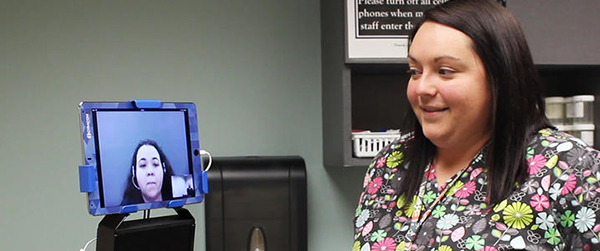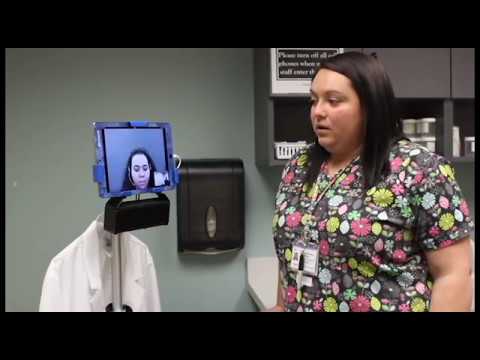Video interpreters close language gaps for pediatric patients at UK

When two girls from India arrived at the International Adoption Clinic at Kentucky Children’s Hospital for their post-adoption health screening, they were nervous and unable to communicate with the doctor and their new parents. But then a face appeared on a screen and spoke to them in Hindi. The girls lit up at the sound of their native language.
The “face on the screen” was the Video Remote Interpreter (VRI), one of nine units used in UK HealthCare’s pediatric clinics for interpretation for non-English-speaking patients and their families.
“The VRI are a newer tool for us at UK, and Pediatrics is the first division to really take the initiative to deploy the units,” said Sarah Hesler, manager of language services for UK HealthCare. “Video interpreting is a great option for our providers and families.”
More than 220 languages available
UK HealthCare offers staff interpreters, dedicated phone interpreters and translated written material, but sometimes those options can’t address a patient’s need. Communications problems include:
- A patient might speak a language or dialect not spoken by a staff interpreter.
- The phone interpreter might have trouble understanding who is speaking, especially when there are several relatives in the room.
- Because written materials aren’t two-way communication, a patient might not have a way to express additional questions or concerns.
The VRI units are designed to fill in those gaps.
“I think one advantage (the VRIs have over phones) is the way kids interact with it,” said Matthew Horn, ambulatory director for pediatric care at UK HealthCare. “Most kids are used to iPads now, so having this on an iPad makes the child a little more comfortable – especially if the face on the screen looks like them.”
Filling a need for communication
UK clinics contract their phone and video interpreting to Cyracom, a company specializing in medical translation for patients and doctors. Phone and video calls are routed to one of Cyracom’s contact centers, where interpreters are available for more than 220 languages by phone and 40 by video.
“You might be surprised that we have that need in Lexington, but last year we saw over 90 spoken languages at UK,” Hesler said.
In 2017, there were more than 130,000 visits across UK’s eight pediatric clinics, 8 percent of which required language services. The VRI units were first introduced in the Twilight Clinic, UK’s after-hours primary care clinic for children and adolescents, and after working well there, were introduced in UK HealthCare’s other pediatric clinics. Because the units are on wheels, language services can be delivered without lapses in communication as the patient moves, for example, from the exam room to X-ray.
“The physicians have been very pleased, and it’s much easier than having to lug the telephone around,” Horn said.
Making the units child-friendly
The staff have given the VRIs names and costumes to make them more fun and engaging for children. “Dr. Rosetta Stone” serves the adolescents clinic. “Pedro” can be found at Kentucky Clinic South, and “Kevin the Minion” works hard in Pediatric Specialty Clinic.
“‘Kevin’ is a frequent flyer: We use him during busy surgery clinics to expedite triage when the Spanish interpreter has not yet arrived,” Horn said. “He has proven to be a hit for other dialects that are not available in person. We used him recently for a family who spoke a Rwandan dialect. Both the family and the patient were impressed.”
As the VRI units prove to be effective, the staff of Language Services hopes to expand their use to the rest of UK’s hospitals and clinics.
It’s essential to patient safety and the quality of care that providers be able to understand and be understood, Hesler said. By using the units so well, “Pediatrics has demonstrated their commitment to superior communication and care.”





